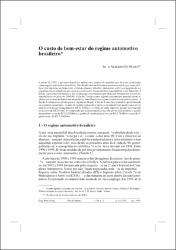Please use this identifier to cite or link to this item:
https://repositorio.ipea.gov.br/handle/11058/5032Full metadata record
| DC Field | Value | Language |
|---|---|---|
| dc.contributor.author | De Negri, João Alberto | - |
| dc.contributor.other | Abreu, Marcelo de Paiva (Observações) | - |
| dc.contributor.other | Bevilaqua, Afonso S. (Observações) | - |
| dc.contributor.other | Susigan, Wilson (Observações) | - |
| dc.coverage.spatial | Brasil | pt_BR |
| dc.date.accessioned | 2015-10-29T23:09:59Z | - |
| dc.date.available | 2015-10-29T23:09:59Z | - |
| dc.date.issued | 1999-08 | - |
| dc.identifier.uri | http://repositorio.ipea.gov.br/handle/11058/5032 | - |
| dc.description.abstract | A partir de 1995, o governo brasileiro editou um conjunto de medidas que ficaram conhecidas como regime automotivo brasileiro. Não há dúvidas na literatura internacional de que essas políticas têm impactos no bem-estar. Existem algumas dúvidas, entretanto, sobre sua magnitude e o segmento da sociedade em que recaem esses custos. Nosso objetivo é quantificar esses impactos. A Seção 1 apresenta um histórico das medidas governamentais que afetaram diretamente o setor automobil ístico no período 1990/98. A Seção 2 relata como alguns economistas quantificaram os efeitos em termos de bem-estar de políticas semelhantes ao regime brasileiro em outros países. A Seção 3 estima esses efeitos para o regime no Brasil. A Seção 4 conclui o trabalho, apresentando os seguintes resultados: o custo do regime automotivo para o consumidor nos quatro anos de vigência será de aproximadamente R$ 35 bilhões e o custo de cada emprego gerado ou poupado será perto de R$ 356 mil. Pressupondo que a elasticidade-preço da oferta seja unitária, o ganho do produtor seria de R$ 24,5 bilhões, o ganho de renda do governo, de R$ 3,7 bilhões e a perda líquida total, de R$ 7,4 bilhões. | pt_BR |
| dc.language.iso | pt-BR | pt_BR |
| dc.publisher | Instituto de Pesquisa Econômica Aplicada (Ipea) | pt_BR |
| dc.title | O custo de bem-estar do regime automotivo brasileiro | pt_BR |
| dc.title.alternative | The welfare cost of the Brazilian automotive regime | pt_BR |
| dc.type | Pesquisa e Planejamento Econômico (PPE) - Artigos | pt_BR |
| dc.rights.holder | Instituto de Pesquisa Econômica Aplicada (Ipea) | pt_BR |
| dc.source.urlsource | http://ppe.ipea.gov.br | pt_BR |
| dc.location.country | BR | pt_BR |
| dc.description.physical | p. 215-242 : il. | pt_BR |
| dc.rights.license | É permitida a cópia, reprodução e distribuição de textos, imagens, dados e demais arquivos, no todo ou em parte, em qualquer formato ou meio desde que sejam observadas as seguintes regras: a) O uso do material copiado se destina apenas para fins educacionais, de pesquisa, pessoal, circulação interna ou outros usos não comerciais. Reproduções para fins comerciais são proibidas; b) O material deve ser reproduzido sem sofrer qualquer alteração ou edição de conteúdo em relação ao original; e c) A reprodução deve ser acompanhada da citação da fonte, no seguinte formato: Fonte: PPE (http://ppe.ipea.gov.br) | pt_BR |
| dc.subject.keyword | Bem-estar | pt_BR |
| dc.subject.keyword | Políticas | pt_BR |
| dc.subject.keyword | Elasticidade-preço da demanda de automóveis | pt_BR |
| dc.relation.references | http://repositorio.ipea.gov.br/handle/11058/3415 | pt_BR |
| ipea.description.additionalinformation | Artigo publicado em: Pesquisa e Planejamento Econômico (PPE), Rio de Janeiro, v. 29, n. 2, p. 215-242, ago. 1999 | pt_BR |
| ipea.description.additionalinformation | Possui referências bibliográficas | pt_BR |
| ipea.access.type | Acesso Aberto | pt_BR |
| ipea.rights.type | Licença Comum | pt_BR |
| ipea.englishdescription.abstract | The Brazilian government has enacted, since 1995, a series of measures which came to be known as the Brazilian automotive regime. There is no doubt in the international literature that such measures have distributive impact, but there are different views about how much and which part of society should bear the cost. This paper estimates the welfare effects of the Brazilian automotive regime. The first part presents a historical of the government s measures that have affected directly the automotive sector in Brazil from 1990 to 1998. The second part reports how some economists have estimated the distributive effects of policies like the Brazilian automotive regime in other countries. The third part estimates the distributive impacts of the Brazilian automotive regime. The synthesis of this paper presents the following results: the cost of automotive regime to consumers during the regime s effective time span will be approximately US$ 33,9 billion. The cost of each job created or saved is about US$ 339 thousand. If it s supposed that the price elasticity of supply is unitary, the gain of producers would be US$ 23,3 billion. The government gains would be US$ 3,5 billion and the death weight loss would be US$ 7 billion. | pt_BR |
| ipea.researchfields | N/A | pt_BR |
| ipea.classification | Economia. Desenvolvimento Econômico | pt_BR |
| Appears in Collections: | Economia. Desenvolvimento Econômico: Artigos | |
Files in This Item:
| File | Description | Size | Format | |
|---|---|---|---|---|
| PPE_v29_n02_Custo.pdf | 145.39 kB | Adobe PDF |  View/Open |
Items in DSpace are protected by copyright, with all rights reserved, unless otherwise indicated.

